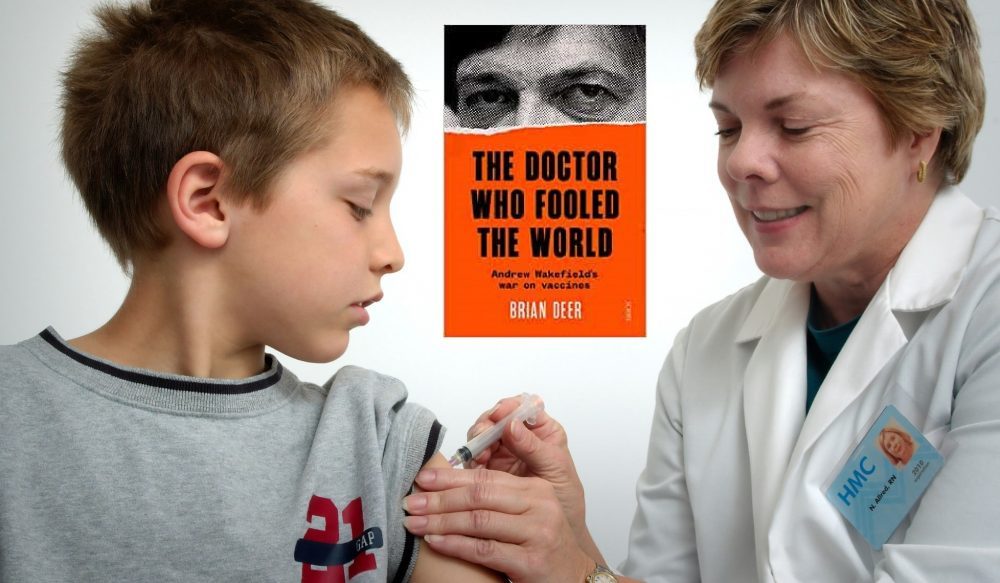
“If he believed in something, he would have gone to the ends of the earth to go on believing.” Andrew Wakefield’s mum.
“Can one person change the world? Ask Andrew Wakefield” New Indian Express editorial.
When I started primary school in a class of 30 there were four of my companions who had callipers and two of them were given chunkier pencils. When my GP gave me a sugar lump on which he had put some liquid neither he nor my mum told me it was to stop getting polio and it was years later I put the callipers and the sugar lump together. I trusted my GP because he was gentle when he looked in my ears and in the early sixties I cannot remember moaning too much when, with my mum, I stood in a long queue extending no less than 8 detached houses up the street, waiting to see my GP standing with his sleeves rolled up at the door to his one roomed surgery. He scratched my arm in front of a flickering blue flame, which would have been scary if it was not him standing there. It was only in my A level days that I understood how Jenner had discovered smallpox vaccine which was used for the last time in West Yorkshire during a localised outbreak.
In my junior doctor days I covered the infectious diseases wards when doing evenings and nights and looked after wards of hot children with coughs and heavily glazed eyes. In my first years as a GP I was tasked to raise the childhood immunisation from “What? How do you mean?” to the 94% which we – the staff, the health visitors and myself – achieved. My two children were fully immunised and I ensured they got the second MMR when it was proven to be needed. I, like the majority, looked on immunisation as an example of modern living and progress… and then, with age and experience only a couple of years less than me, came Andrew Wakefield.
I … looked on immunisation as an example of modern living and progress… and then came Andrew Wakefield.
Brian Deer has described Wakefield in terms he deserves. Born into a medical family, at medical school he was captain in rugby and played at number 8 “needing fearlessness to smack into the enemy” and “his career Plan A was professor of surgery… he would crave that professorship… but his dreams were bigger than that”. And indeed Wakefield has earned himself a wealthy life style in the States, safe in the “kitchen cabinet” of Donald Trump.
Brian Deer vindicates the purpose of investigative journalism and describes the strain it places on the journalists. At one time he was sued by Wakefield. When Wakefield withdrew the summons Brian Deer went to court to ensure the case continued! As a journalist he has written an uncomfortable page turner.
Wakefield’s formal qualification was as a surgeon with an FRCS. He subsequently described his “training” in virology as follows: “I sat down with two volumes of a virology textbook, and worked through it”, the book being “Field’s Virology, Second Edition”. Wakefield, claiming to be backed by science, suggested that measles vaccine caused Crohn’s disease and, despite no training in paediatrics or psychiatry, he then related the measles vaccine to autism via a new “inflammatory bowel disease”. When others contradicted his results he devised invalid tests performed in laboratories he owned. For reasons of medical politics alone he was given an expensively furnished and equipped research ward supported by those who wanted to promote their own progression and, as a “research assistant”. He became “a doctor without patients”, able to admit and investigate 12 children selected because their parents had heard of him through “Jabs” (an anti-vax group). For those in primary care, we need to remember that these children had referral letters from GP’s but in most cases the GP was phoned by Wakefield requesting the referral or the parent asked the GP for the referral prompted by talking to Wakefield. The nearest distance a child lived to the unit was 60 miles.
When others contradicted his results he devised invalid tests performed in laboratories he owned.
Whilst subjecting these 12 children to ileocolonoscopies, lumbar punctures and other investigations, most of which had to be done under sedation, he hypothesised that triple MMR vaccine caused more “damage” than the monovalent vaccine. He himself organised a press briefing where he previewed his paper on the 12 children, which he had de facto written himself, despite being published in the Lancet with a list of thirteen authors. During the briefing the Dean wanted to present the rising incidence of measles in Europe and its resulting morbidity and fatality. But such facts were displaced in the press and TV by the more dazzling presentations of Wakefield who was supported by “Jabs” which rejoiced in the findings. Parents of children who were initially sent home with “normal” findings were subsequently told to obtain Mesalazine or similar to treat their children’s behaviour problems. The 12 children obviously suffered discomfort and distress but Wakefield’s ward was for research – one child “was so ill, and repeatedly vomiting, that on Friday he was put in a taxi with his mother and driven 280 miles home”. When, in 2010, the children’s notes were reviewed by the GMC it was found that the results presented in the Lancet as “ abnormal” were reported by the pathologists who saw them as “normal”.
When the children’s notes were reviewed by the GMC … results presented in the Lancet as “ abnormal” were reported by the pathologists who saw them as “normal”.
Having summarised this chronology in the first section of his book Brian Deer then goes on to explain how Wakefield was able to use findings with no scientific basis to change the minds of parents and, sadly, the press, to the benefits of immunisation. Wakefield presented his dozen patients and was heralded as a “consultant gastroenterologist”, “consultant Paediatric gastroenterologist”, “director of research group” and “reader in experimental gastroenterology” – titles which Brian Deer points out had no more basis than his theories. He had the FRCS but failed to keep up the annual subscription in spite of being funded by various the commercial laboratories which he set up and other legal and commercial agencies who had vested interests in his work being accepted as truth. Thankfully – after taking several conferences by storm and beating back questions from experienced clinicians he was found out and dismissed from his UK post, leaving an MMR vaccine uptake rate in the UK below that needed for herd immunity.
In 2010 the GMC withdrew his registration and the Royal Society of Pathologists withdrew his honorary fellowship. His travel had brought Wakefield into contact with US legal firms, keen to adopt him as their expert and so a new and even more lucrative phase of his career developed in the US. Initially he had vocal support from Donald Trump and can be seen on his inauguration photos but, faced with an epidemic of measles, Trump changed his mind. Social media then offered Wakefield a new means of promoting his ‘anti-vax’ campaign with worldwide consequences, even though he had still never actually, ever, treated a patient. In Europe in 2018-2019 there was an epidemic of measles. Wakefield now lives a millionaire lifestyle, Brian Deer lives in a London flat. Those who believed supporting Wakefield would promote their careers are remembered for “Wakefield” and none of their other achievements. Other doctors whose name he tagged on to the Lancet article lost their registration.
This book needs to be read widely – it is aimed at a mixed audience and so has several sections in which Brian Deer explains the scientific jargon used by Wakefield and the scientific method used to disprove him but that is needed because it clearly explains the myths which the lay press were prepared to disseminate. What we all need to reflect on are the motives of those who, seeing his results totally rubbished by recognised experts in all specialities who had studied thousands of children, still supported his claims. This book helps us to do that.
The future challenge to immunise our patients will be between such as Wakefield, and others such as my childhood GP.
In the age of Covid, Brian Deer presents challenges to the medical profession and especially primary care. The anti-vax movement is well funded, as can be seen in Wakefield’s current lifestyle, and his original influence was the result of his charisma and presentation and the way the media were presented complicated tables of results and terminology in simple short catchy and memorable phrases which could light up the front pages and wake up the evening viewers. We need to accept that the future challenge to immunise our patients will be between such as Wakefield, and others such as my childhood GP, renowned for his kindness and understanding, standing at his doorway with his sleeves rolled up to use minimal resources for the maximal benefit of all those who he took to be entrusted to his care. The profession will all need to roll its sleeves up and stand before our patients illuminated by the light and flame of truth.
Featured book
Brian Deer Scribe, The Doctor Who Fooled the World. Scribe UK, 2020.








